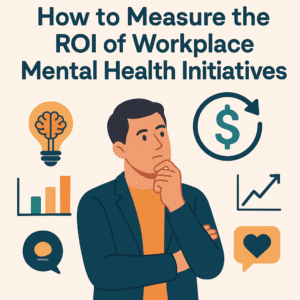It's no longer just about offering an Employee Assistance Program and calling it a day.
Your employees are expecting more, and frankly, your business needs it too.
The companies that get ahead of these trends will be the ones attracting top talent while others struggle with turnover and disengagement.
Mental health is becoming as strategic as your quarterly goals, and the organizations that treat it that way are seeing real results.
Whether you're a small startup or a Fortune 500 company, understanding where workplace mental health is heading will help you build a workforce that's not just productive, but genuinely thriving.
The shift is happening now, and you have the opportunity to lead it.
The Rise of AI-Powered Mental Health Tools

Imagine having a system that could alert you when your star performer is showing signs of burnout before they even realize it themselves.
That's exactly what AI-powered mental health tools are making possible for forward-thinking employers like you.
These platforms don't just react to problems – they predict them by analyzing patterns in how your employees communicate, their meeting schedules, and even their typing patterns.
Microsoft has already integrated AI wellness features that tell employees when they're in too many back-to-back meetings.
Your company could soon have similar tools that suggest when someone needs a break or connect them with the right resources at exactly the right moment.
Think of it as having a mental health early warning system for your entire organization. Here's what you can expect from these tools:
- Around-the-clock support that works even when your HR team is offline
- Personalized recommendations based on each employee's specific stress patterns
- Real-time insights about your team's collective well-being
- Cost-effective scaling that grows with your company
You'll want to be transparent about how you're using employee data and ensure these tools complement your existing support systems rather than becoming a substitute for genuine human care.
Shifting from Reactive to Preventive Mental Health Programs
Stop waiting for your employees to hit rock bottom before offering help.
The most successful companies are flipping the script entirely, creating environments where mental health support happens before crisis strikes.
You're essentially building a safety net that catches people before they fall, rather than picking them up afterward.
This means rethinking everything from how you schedule meetings to how you distribute workloads.
Instead of cramming five meetings into a morning, you might build in buffer time.
Rather than loading your high performers with endless projects, you could implement workload monitoring that prevents overwhelm.
The following table illustrates what reactive vs. proactive approaches look like.
| Reactive Approach | Preventive Approach |
| Wait for crisis calls | Regular check-ins and early support |
| Individual problem-solving | Team-wide wellness initiatives |
| Hushed conversations | Open mental health dialogue |
| Limited crisis resources | Comprehensive support ecosystem |
| Emergency spending | Strategic wellbeing investment |
The goal is making mental health support as normal and accessible as your coffee machine.
Manager Mental Health Training Becomes Mandatory

As a leader, you are probably already doing mental health work.
Every time you notice someone seems off, handle a performance issue, or deal with team conflict, you're operating in the mental health space.
The problem is you may feel completely unprepared for these moments.
That's why smart companies are making mental health training mandatory for anyone in a leadership role.
You're not becoming therapists, but you're being given the confidence to recognize when someone might be struggling and know exactly what to do next.
Effective training programs teach leaders to:
- → Spot early warning signs without being invasive
- → Start supportive conversations that feel natural, not clinical
- → Navigate the line between being helpful and overstepping boundaries
- → Connect employees with appropriate resources quickly and discreetly
- → Model healthy behaviors for their own teams
Your investment in their training pays dividends in team performance, retention, and workplace culture.
It is becoming a reality that the traditional 9-to-5 model doesn't work for everyone's mental well-being.
Some people are night owls, others need midday breaks for therapy appointments, and many are juggling caregiving responsibilities that don't fit neat work schedules.
The companies winning the talent war are those offering real flexibility, not just remote work options.
You might consider compressed workweeks that give people longer recovery periods, or flexible hours that accommodate different energy patterns and life responsibilities.
Some organizations are even offering mental health days separate from regular sick leave, recognizing that psychological rest is as important as physical recovery.
Burnout prevention, on the other hand, requires more than flexible schedules. You need to look at workload distribution, role clarity, and performance expectations.
Are you inadvertently creating unsustainable pressure? Are your high performers carrying too much because they're reliable?
Consider these flexible approaches:
- Four-day workweeks with longer daily hours but extended weekends
- Core hours when everyone's available, with flexibility around the edges
- Mental health days that don't count against sick leave
- Remote work options that reduce commute stress and increase life integration
- Clear policies about after-hours communication (and enforcing them)
Measurement, Outcomes, and Return on Investment (ROI)

You can't manage what you don't measure, and that's especially true for mental health initiatives.
Gone are the days when you could implement a wellness program and hope for the best.
Today's successful companies are tracking specific metrics that show whether their mental health investments are working. This doesn't mean turning your workplace into a data collection nightmare.
Instead, you're looking for meaningful indicators that tell you if your people are thriving.
Regular pulse surveys can reveal trends before they become problems.
Exit interviews might show whether mental health support influenced someone's decision to stay or leave.
Healthcare cost analysis can demonstrate real financial impact. The most effective measurement strategies focus on both leading and lagging indicators.
You want to know not just what happened, but what's likely to happen next.
Are people using your mental health resources? Are managers having more supportive conversations? Are teams reporting higher psychological safety? Your measurement ROI toolkit might include:
- Monthly wellbeing check-ins that track mood and stress levels
- Participation rates in mental health programs and resources
- Absenteeism patterns and their relationship to workload or team dynamics
- Manager confidence surveys about handling mental health situations
- Healthcare claims analysis for mental health-related expenses
We Can Help You With Your Mental Health Program
At Mental Health Solutions, we offer comprehensive mental health training that empowers employees to prioritize their mental well-being, boost resilience, and enhance productivity.
Let us help you build a supportive and thriving workplace that your employees deserve and your business needs. Contact us today.

